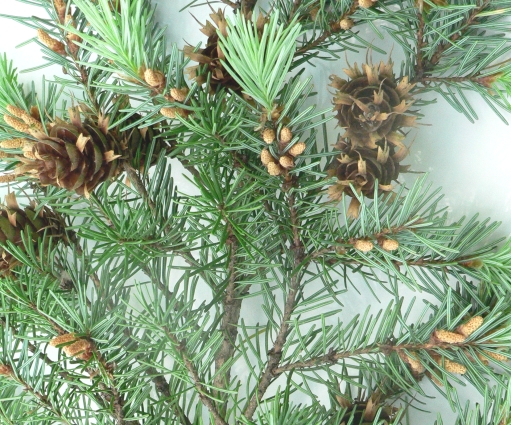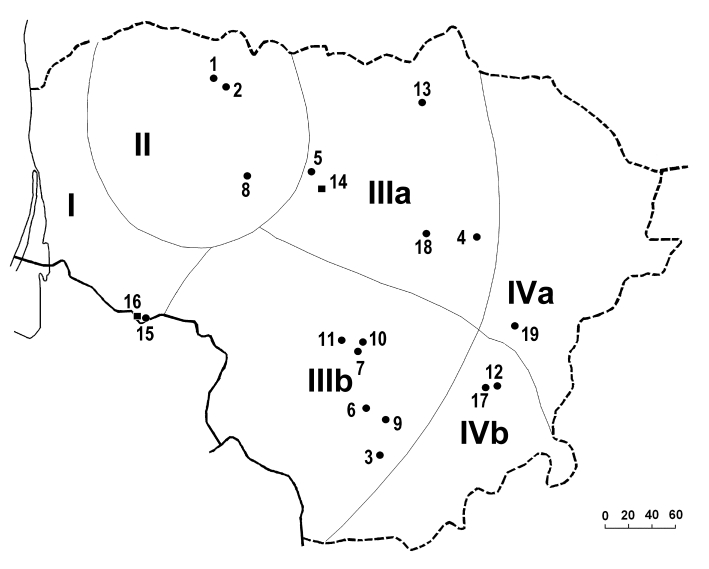
Rocky Mountains Douglas fir (Pseudotsuga menziesii var. glauca (Beissn.) Franco) and green Douglas fir (Pseudotsuga menziesii (Mirb.) Franco) are introduced trees in Lithuania. Douglas fir was introduced in Europe by D. Douglas in 1825–1827 and was firstly planted in Lithuania approximately 90–100 years ago together with other introduced trees (Januškevičius et al., 1990).
According to the inventory data, about 60 sites of mature Douglas fir trees were reported during the 20th century in Lithuania. Rocky Mountains Douglas fir is more common than green Douglas fir in them (Januškevičius, 2004; Ramanauskas, 1973; Snarskis and Galinis, 1974; Tauras, 1989). To date, there are only a few sites where mature Douglas fir trees grow in Lithuania. Trees have died off due to unknown reasons in several parks, e.g. Kuršėnai Park, Šereitlaukis Park, Bebrujai forest, Pienionys Park, Vyžulionys Park and several other sites. Mature trees grow mainly in the western and central part and are rare in eastern Lithuania (Januškevičius, 2004; Ramanauskas, 1973; Žeimavičius, 1995; Žeimavičius, 2002). The first dendrochronological research on Douglas fir in Lithuania was performed in 1984. Research has shown a strong negative influence of colds in winter and spring on the radial growth of Douglas fir (Žeimavičius, 1995; Žeimavičius and Budriūnas, 1990). Investigations at the end of the 20th century have indicated a decline and increased mortality of trees (Žeimavičius, 2002).
For the investigation, 19 research plots of Douglas fir were selected in Lithuania (Figure 2). As a result, 19 local chronologies on the radial growth of Douglas fir were constructed. The longest chronologies contain 95 years and encompass from two to 23 trees. We found a very high similarity (correlation) among sites (p < 0.01). The masterchronology from 187 trees (15 plots) was constructed (Vitas and Žeimavičius, 2006).
Multiple regression has demonstrated the positive impact of air temperature in winter and spring and a strong positive influence of precipitation in June (east Lithuania). Analysis of pointer years revealed the minimal number of negative pointer years in the seaside lowlands and Žemaičiai uplands regions. It shows the more favourite growing conditions for the Douglas fir in western Lithuania (Vitas and Žeimavičius, 2006).

A comparison of the main climatic factors limiting the radial growth of Douglas fir with the factors strongly connected to other conifer species, which naturally grow in Lithuania, has shown that Douglas fir takes the middle position between Norway spruce and Scots pine. Summer droughts strongly limit the radial growth of spruce, and pine is sensitive to low air temperatures at the end of winter and spring (Vitas and Žeimavičius, 2006).
Previous research conducted on Douglas fir in Lithuania has indicated the decline of trees from 1988 to 1999 (Žeimavičius, 2002). It was found that more than 50 % of recorded mature trees died during this period, and in 1999, there remained only 59 trees compared to 118 trees in 1988. Trees died off and were cut in three growing places during 1990–2000: Pienionys Park, Vyžulionys Park and Bebrujai Forest. The growth patterns of Douglas fir in Vyžulionys Park and Bebrujai Forest show a sharp decrease in the radial growth in 1992 compared to 1991 (Vitas and Žeimavičius, 2006, Figure 3). Such a decrease in the radial growth of a tree persisting for several years is operated by drastic changes in eco-physiological conditions, which inhibit the cambial activity. The radial growth of several species has shown negative pointer years due to the extreme drought in 1992. It is typical, especially for Norway spruce growing in Lithuania. This decrease in the radial growth of Douglas fir could also be connected to the invasion of pests. It is well known that the invasion of pests leads to high mortality of trees already declined by extreme climatic conditions. Thus we think that extreme droughts have played a predisposing factor for the decline of Douglas fir (Vitas and Žeimavičius, 2006).
